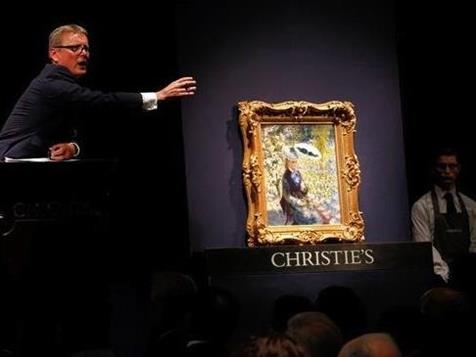How do art auctions work?

Forget elitism – we bring you a glossary that demystifies the art auction, opening a door on a whole other world of collecting.
Art Auctions are big business. On any year, international headlines report record sales of “trophy consignments”, those multi-million dollar sales that send jaws dropping and the mind reeling. It is not surprising that many of us box the art auction as a blood sport for the rich, wondering whether this world has any reality once you move beyond that top tier?
Art auctions can be an exciting and attainable way of purchasing art. And with the technology today, the auction has become a more democratised world where we can play out our own passions and interests in art.
Generally, the art market has long been criticised as being too obscure and opaque.That is changing. Programs like Art Month Sydney, for example, which aim to demystify collecting and the recent introduction of Art Money to make art shopping easier* are but two local stimulants to bring art collecting into the everyday.
Recent auctions in March sold lots ranging from $100 – $100,000. In theory, price and possession is determined by the simple rule: you want something then you pay more than anyone else. Auctions operate on the foundation of business we all understand – supply and demand.
Sounds simple enough. We give you the definitive beginners guide on how to join this rising trend (beware its addictive) and demystify the lingo with a go-to glossary to get started.
Auctioneer: An art auction is a wonderful piece of theatre. Often fast paced, the auctioneer commands the room not unlike a conductor, pointing in rhythmic gesture to successful bidders, his gavel (hammer) held pensively aloft ready to land with a decisive clap. The auctioneer will introduce the lot for sale recapping key catalogue information before calling for bids. He/she announces the starting bid and will then responded to raised bidders’ paddles in the room or from the phones, automatically raising the price through fixed increments (see below).
The auctioneer will repeat the paddle number of the successful bidder, reminding that the last bid “is held with the lady in the front” and encouraging “the gentleman at the rear of the room”, for example. Eye contact is key. There will be plenty of “fair warning”, often lingering with the hope of wheedling further bidding, before the gavel drops.
Don’t be shy if you are bidding; that initial bid is key to identifying you to the auctioneer. He/she will do the rest then in leading you through a purchase. Bidding is the easy part – too easy sometimes.
Their job is to work the room, and know the room. The auctioneer would be aware of bidder’s interests in key lots prior to the sale. And don’t be surprised if the sale is split across two auctioneers; it is a mentally and physically exhausting task to sustain energy across hundreds of lots.
Bidding Increments: Bids jump automatically. The increments are outlined in an auction’s catalogue and tend to reflect the price point. For example a $100 estimate might go up in $50 jumps while a $100,000 work in $5,000 increments. Be aware of the set increment for any given lot when registering to bid.
The auctioneer has discretion over the sale and can accepts bids of split increments, but this is usually towards the end to push a lot over the line. The Auctioneer also has the discretion to withdraw or reoffer a lot in the event of dispute.
Buyers Premium: The buyer’s premium or BP refers to the amount the auction house adds to the price of the sale, that is the hammer price. It is usually 20%, which then escalates to 22% with GST. A good trick is to calculate this in advance so you know the real price you are bidding.
Consignments: The auction house will call for the consignment of artworks / fine art and decorative objects from potential vendors (that is collector’s wanting to sell) well in advance of a sale. Auction houses advertise forthcoming auctions on their website, which are usually themed. Each house has a team of “experts or specialists” who are keen to bring fresh work onto the market; a conversation will usually lead to a photograph emailed and then a visit to assess the work for condition and potential sale. It is a competitive market for auction houses to build a strong sale, and relationships are extremely important in this sector. The auction house will take a Seller’s Commission on the sale It is a competitive market for auction houses to build a strong sale, and relationships are extremely important in this sector.
Condition report: The condition of a work will affect its value dramatically. Prior to any sale the offered lots are presented at a preview where the potential viewer can examine the artwork first hand. It is not uncommon to request a condition report on a lot (at a cost) – and if you are savvy you may ask if one has been requested – the auction house will usually disclose if so. Never be afraid to ask what kind of interest there is in a lot. And remember it is your responsibility to inspect before you buy.
Estimates: The auction house will set a price range for the lot, which is expressed as the low and high estimate. It is based on the period the artwork is from, its provenance, rarity, condition and quality.Past auction results may also be a factor in gauging the estimate of like works, which is information that you can request from the auction house or research yourself.
When auction results are reported they are usually done so against the estimate, as an indication of how strongly interest pushed the work beyond market expectation. The overall sale will also be reported as reaching a percentage by value, which indicated who the overall sale performed in relation to those pre-sale estimates.
GST (Goods & Service Tax): Auctions attract GST. Buyers are required to pay 10% GST which is a sum of:
- 10% of the final bid price when buying from a GST registered vendor; and
- 10% of the buyer’s premium (for example 2% added to the standard 20% BP) and any additional fees charged by auction house, such as appraisals, condition reports, freight, conservation and so on.
If the buyer is a “non-resident” / international bidder they can recover GST paid on the final purchase price under certain conditions.
Internet Bidder: This is one of the fastest growing buyers in the auction sector. If an auction house is offering the facility of internet bidding it will advise so. You will need to register to bid with that facility, for example Invaluable. You can watch the auction live and bid live. The internet bidder is not known in the room at the sale – ie. they do not have a paddle number consistent with other registered, absentee and telephone bidders – however there is usually a staff member assigned to, following and registering the bids in the room, seamlessly connecting all bidders in the sale.
Hammer: Described by some as the auctioneer’s Excalibur and by other’s a conductor’s baton, the hammer indicates the winning bid, sometimes with a light tap and at others with a definitive slam. It should be noted that this amount is before the Buyer’s Premium (BP) is added, so be careful. A good trick when you know what lots you are bidding on is to calculate the bidding increments with the BP so you are aware of your cut-off point well before getting caught up in the energy of the room. When an auction is moving fast you don’t have the time to calculate the final “wack on the plastic”.
Paddle / Registered Bidder: While it might look like a ping-pong paddle, and can deliver an equally decisive blow to an opponent, the Paddle – displaying a number – is a simple device for anonymously identifying registered bidders. Anyone bidding on the day needs to register. This can be done in advance as an Absentee or Telephone Bidder, or simple sign up on arrival at the event. You will need to present ID.
Some seasoned or high-flying collectors opt for a more discreet approach, raising a piece of paper, finger or a nod of the head. This is predicated on the auctioneer being aware of these signs, with the number recorded only on the closure of a sale. A hint – don’t use it as a fan!
Provenance: This is a history of the artwork’s movement, that is whose hands the artwork has passed through from its purchase to its current offering, and it is usually published in the auction catalogue. Gaps in provenance should be questioned. Sometimes the celebrity of the owner or the prestige of the collection are important factors in bolstering desirability and price.
An auction catalogue may also list the major exhibitions or catalogues an artwork has been presented in.
Reserve: The minimum price that a consignor will allow the auction house to sell an artwork for, meaning that if bidding fails to rise to the level of the reserve the work will be bought in (not sold). This is pre-arranged before the sale, and is optional. The reserve price includes GST (if applicable, see GST).
Telephone / Absentee Bidder: In our busy times, and given that auctions have become so global, often a bidder is unable to attend an auction. This may also be a simple case of preferring to remain anonymous, so a buyer will pre-arrange an alternative way of bidding. This can be done be an agent acting for them, e.g. an art advisor or art dealer, or may bid live over the telephone working with one of the auction house staff assigned to them for the sale.
Unsold lots: Across a sale, lots will be passed, usually because they had not reached the reserve. Often the auctioneer will advise the room that they will confer with the consignee and interested parties. It is not unusual that a sale can be negotiated and completed within the hours or days that follow.
Auctions can be a savvy way to buy art and need not be as intimidating as they seem. Auction houses title their staff as “experts or specialists” for a reason – ask questions – their job is to make this process as easy and as enjoyable as possible for you.
And if you are feeling a little nervous, watch an auction online first, attend one and get a sense of the energy in the room, or why not register as a phone bidder and let the staff lead you through your purchase.
But as with all collecting – do your homework first. Know your limits, know your back up purchases – and enjoy! It can be thrilling and addictive.
* Art Money was launched last month and is currently not available to purchases at auction.
Top Image: Source Christie’s
First published on ArtsHub 13 April 2015.



Leave a Reply
You must be logged in to post a comment.